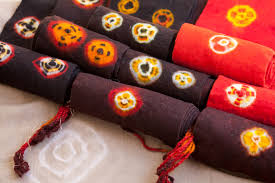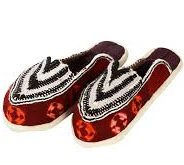
Textiles, Weaving, Spinning, Khadi, Tie-dye, Bandhani, Shibori
Thigma/ Tie-Dye Technique on Wool of Ladakh
This process involves resist-dyeing on woollen cloth. Chief centers for practicing this craft are the Nubra valley and Sabu. Products like panels for garments called Nambus, belts called skerekh and narrow belts are created under thigma. The tools used for practicing this craft are thread and cord.
A resist tie-dye technique on wool – Thigma is similar to the technique of Bandhani. Crafted mainly in Nubra Valley, Ladakh the term Thigma is a derived from the word “thitoo‟ or dot.
This cloth tie-dye resist is done on narrow strips of woollen cloth. The wool strips are used as panels in dress, blankets and on the high-boots used in Ladakh
The cloth is pinched, without any tools and the part to be resisted is tied tightly with thread. The tie-dye dot motifs are usually done in multicolours to form a spiral patterning of shades in the tie-dye parts. The colours used are natural dyes made of apple bark and onion peel for light browns, charcoal soot for shades of grey, the root of the chutza for yellow and the roots of the chzot for pink.




YOUR VIEWS
PRACTITIONERS: INDIA
Access 70,000+ practitioners in 2500+ crafts across India.
BIBLIOGRAPHY
10,000+ listings on arts, crafts, design, heritage, culture etc.
GLOSSARY
Rich and often unfamiliar vocabulary of crafts and textiles.
SHOP at India InCH
Needs to be written.





